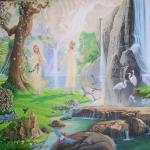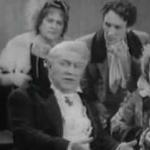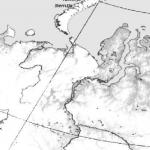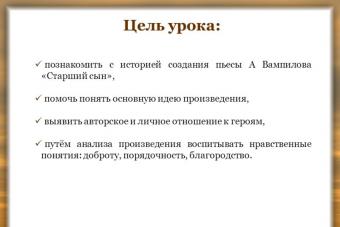Biography of Tolstoy Lev Nikolaevich (1828 - 1910)

PEDIGREE
Great-grandfather Andrei Ivanovich served as president of the Main Moscow Magistrate.
His two sons served the Fatherland: Pyotr Andreevich - an associate of Peter I, Ilya Andreevich - an officer of the Preobrazhensky Regiment. He married the daughter of the Minister of War, Pelageya Nikolaevna Gorchakova.

The son of Ilya Andreevich, Nikolai Ilyich Tolstoy, a participant in the War of 1812, in 1820 married Maria Nikolaevna Volkonskaya, the daughter of a retired general close to Catherine II. Children were born in the family

Leo Nikolayevich Tolstoy was born in Yasnaya Polyana on August 28, 1828. When Lyovushka was 2 years old, her mother died. The closest person was a distant relative of the grandmother Pelageya Nikolaevna, Tatyana Aleksandrovna Ergolskaya.


Moving to Kazan in 1841.
Here in 1844 L. Tolstoy entered the Kazan University. For a year he attends classes at the Faculty of Philosophy (Department of Arabic-Turkish Literature) and for two years at the Faculty of Law.
In 1847 Leo Tolstoy left the University

CAUCASUS AND CRIMEAN WAR
In 1851, together with his elder brother Nikolai L. Tolstoy, he left for the Caucasus in the army, where he served first as a volunteer, and then as a junior artillery officer.

With the beginning of the Russian-Turkish war, L. Tolstoy submits a memorandum on his transfer to the Danube army. As an artillery officer of the fourth bastion, he participated in the defense of Sevastopol.
He returned home at the end of 1855 with the Order of St. Anna "For Bravery" and medals "For the Defense of Sevastopol".

Literary activity of the first half of the 1850s.
1852 - the story "Childhood", published in "Sovremennik", later "Boyhood" (1854) and
"Youth" (1856).
In 1855, L. Tolstoy completed work on "Sevastopol Tales"

Literary activity of the second half of the 50s.
Returning from Sevastopol, Leo Tolstoy plunged into the literary environment of St. Petersburg.
In 1857 and 1860-61 L.N. Tolstoy traveled abroad in Europe. However, he did not find peace of mind here.
1857 - the stories "Albert", "From the notes of Prince Nekhlyudov", the story "Lucerne"
1859 - the story "Three Deaths"

Pedagogical activity
Back in 1849, L.N. Tolstoy began classes with peasant children.
In 1859 he opened a school in Yasnaya Polyana.
In 1872, L. Tolstoy wrote the "ABC", which was published 28 times during the life of the writer.

Life and creative maturity (1860-1870s)
1863-69 - "War and Peace"
1873-77 - "Anna Karenina".
According to the writer, in the first work he was fond of “folk thought”, in the second – “family thought”.
Shortly after publication, both novels were translated into foreign languages.

SPIRITUAL CRISIS
1882 Finished autobiographical work "Confession": "I renounced the life of our circle..."
In 1880-1890 L.N. Tolstoy created a number of religious works in which he outlined his understanding of the Christian dogma.
In 1901, the Holy Synod excommunicated Leo Tolstoy from the church.

Literary activity 1880-1890
In the early 1889s, Leo Tolstoy's views on art changed significantly. He came to the conclusion that he should not write "for the masters", but for "Ignats and their children"
1889-1899 - "Resurrection"
1886 - "Death of Ivan Ilyich"
1887-89 "Kreutzer Sonata"
1896 1904 - "Hadji Murad"
1903 - "After the ball"

FAMILY LIFE
In 1862, Lev Nikolaevich marries the daughter of a Moscow doctor, Sofya Andreevna Bers. After the wedding, the young immediately leave for Yasnaya Polyana.



Last years.
Relations with his wife and children were strained. They finally deteriorated after a secretly written will, according to which the family was deprived of the right to the literary heritage of the writer.

On the night of October 27-28, 1910, Leo Tolstoy secretly left his home and went to the south of Russia, where he planned to stay with familiar peasants.
Biography of Leo Tolstoy L.N. TOLSTOY (1828-1910). BIOGRAPHY. Leo Tolstoy was born on September 9, 1828 at the Yasnaya Polyana estate, near Tula, into a noble family.
- Without my Yasnaya Polyana, I can hardly imagine Russia and my attitude towards it. Without Yasnaya Polyana, perhaps I see more clearly the general laws necessary for my fatherland...
- L.TOLSTOY, "Memories in the countryside"
- I don't remember my mother at all. I was one and a half years old when she passed away...everything I know about her, everything is fine...
- L. Tolstoy "Memories"
- The first place ... occupies, although not by influence on me, but by my feeling for him, ... my father.
- L. Tolstoy "Memories"
- Finally today I received the order to go to my battery, I am a 4th class fireworker. You won't believe how much it gives me pleasure.
- L. Tolstoy - T. A. Ergolskaya. January 3, 1852
- A group of writers of the Sovremennik magazine.
- L.N. Tolstoy, D. V. Grigorovich, I. A. Goncharov,
- I.S. Turgenev, A. V. Druzhinin, A. N. Ostrovsky.
- From a photograph of 1856.
- The choice has long been made. Literature-art, pedagogy and family.
- L. Tolstoy, Diary, October 6, 1863
- She is a real help to me.
- L. Tolstoy - A. A. Fet.
- May 15, 1863
- When I enter the school and see this crowd of ragged, dirty, thin children, with their bright eyes and so often angelic expressions, anxiety comes over me, the horror that I would experience at the sight of drowning people ... I want education for the people ... to save those Pushkins drowning there, ... Lomonosovs. And they teem in every school.
- L. Tolstoy - A. A. Tolstoy. December 1874
- TOLSTOY is indeed a great artist, such as are born over the centuries, and his work is crystal clear, bright and beautiful.
- V. G. Korolenko
- ... There is no person more worthy of the name of a genius, more complex, contradictory and beautiful in everything ...
- A. P. Chekhov
- Demonstration in St. Petersburg on the death of Leo Tolstoy.
- 1910
- Grave of Leo Tolstoy in Yasnaya Polyana.
- The historical significance of Tolstoy's work ... is the result of everything experienced by Russian society over the entire 19th century, and his books will remain for centuries, as a monument to hard work done by a GENIUS ...
- M. GORKY
Elena Antipova
Presentation "Leo Tolstoy"
a lion Tolstoy Born September 9, 1828 in the estate of Yasnaya Polyana, Tula province. He was the fourth child in a large noble family. Tolstoy was orphaned early. His mother died when he was not yet two years old, and at the age of nine he lost his father. Guardian of five children Tolstykh became an aunt - Alexandra Osten-Saken. The two older children moved in with their aunt in Moscow, while the younger ones stayed in Yasnaya Polyana. It is with the family estate that the most important and dearest memories of Leo's early childhood are connected. Tolstoy.
Alexandra Osten-Sacken died in 1841 and thick moved to Aunt Pelageya Yushkova in Kazan. Three years after the move, Leo Tolstoy decided to enter the prestigious Imperial Kazan University. However, he did not like to study, he considered exams a formality, and university professors - incompetent. Tolstoy did not even try to get a scientific degree, in Kazan he was more attracted to secular entertainment.
In April 1847, Lev's student life Tolstoy ended. He inherited his part of the estate, including his beloved Yasnaya Polyana, and immediately went home without receiving a higher education. At the family estate Tolstoy I tried to improve my life and start writing. He made his plan education: study languages, history, medicine, mathematics, geography, law, agriculture, natural sciences. However, he soon came to the conclusion that it is easier to make plans than to carry them out.
Related publications:
So, having thought over all the information entering my violent head, I decided on the project "We are going to the Emerald City on a difficult road." Now all.
 Today I want to bring to your attention the material on the lexical topic "ANIMALS OF HOT COUNTRIES". Plan - summary of the OOD for the application "Lev.
Today I want to bring to your attention the material on the lexical topic "ANIMALS OF HOT COUNTRIES". Plan - summary of the OOD for the application "Lev.
 Good day! Today I want to talk about the application that the guys and I did when we had a lexical topic "Animals.
Good day! Today I want to talk about the application that the guys and I did when we had a lexical topic "Animals.
An open lesson in fiction for older preschoolers “A. Tolstoy "The Golden Key or the Adventures of Pinocchio" Topic: A. Tolstoy "The Golden Key or the Adventures of Buratino." Program content: Continue to acquaint children with the fairy tale “The Golden Key.
Summary of the lesson in the 5th grade of the correctional school "A. Tolstoy "Now the last snow is melting" Class: 5 Lesson topic: A. Tolstoy “The last snow is already melting” Lesson objectives: Introduce A. Tolstoy’s poem “The last snow is already melting.
 Purpose: Development of cognitive and creative activity of children. Creation of plasticine crafts by children - "Lion". Tasks: 1. Teach children to share.
Purpose: Development of cognitive and creative activity of children. Creation of plasticine crafts by children - "Lion". Tasks: 1. Teach children to share.
 Age group: second junior Form of organization and number of children: teamwork (group of 15 people) Program objectives: 1.
Age group: second junior Form of organization and number of children: teamwork (group of 15 people) Program objectives: 1.
Artist, thinker, man. Lev Nikolaevich Tolstoy was born on August 28 (September 9), 1828 in the Yasnaya Polyana estate of the Krapivensky district of the Tula province in an aristocratic noble family. “I don’t remember my mother at all. I was 1.5 years old when she passed away. ... She was not pretty, but well educated for her time. She knew ... four languages ..., played the piano well, and ... was a great master of telling fairy tales ”“ Father was of medium height, well-built, lively sanguine, with a pleasant face and always sad eyes. Father never humiliated himself before anyone, did not change his lively, cheerful and often mocking tone. And this self-esteem that I saw in him increased my love, my admiration for him "Mother - Princess Maria Nikolaevna Volkonskaya () Father - Count Nikolai Ilyich Tolstoy ()

The Tolstoy family The first annalistic references to the Tolstoy family date back to the 16th century. Pyotr Andreevich, the first of the Tolstoy family to receive the title of count, was a comrade-in-arms of Peter I. The Tolstoys were related to the families of famous figures in Russian history and culture: Pushkin A.S., P.Ya. Chaadaev, Decembrists S.G. Volkonsky, S.P. Trubetskoy, A.I. Odoevsky

Childhood After the death of his father (1837), a distant relative, T. A. Ergolskaya, who had a huge influence on Tolstoy, took up the upbringing of children: “she taught me the spiritual pleasure of love.” Childhood memories have always remained the most joyful for Tolstoy: family traditions, the first impressions of the life of a noble estate served as rich material for his works, were reflected in the autobiographical story "Childhood".

Adolescence and youth Tolstoy was 13 years old, the family moved to Kazan, to the house of a relative and guardian of the children P. I. Yushkova. For two and a half years he was preparing to enter the university. Deciding to become a diplomat, Tolstoy took exams for the eastern branch.

In Kazan, he successfully passed the exams in history, geography, mathematics, statistics, Russian literature, logic, English, French, German, Latin, Arabic, Turkish and Tatar languages and entered the Kazan University at the Department of Oriental Languages of the Faculty of Philosophy, then transferred to the Faculty of Law faculty, where he studied for less than two years. Classes did not arouse a lively interest in him, and he passionately indulged in secular entertainment. In the spring of 1847, having filed a petition for dismissal from the university "due to frustrated health and domestic circumstances", Tolstoy left for Yasnaya Polyana.

From the diary of L.N. Tolstoy What will be the purpose of my life in the countryside for 2 years? - 1) Study the entire course of legal sciences required for the final examination at the University. 2) Study practical medicine and part of the theoretical one. 3) Learn languages: French, Russian, German, English, Italian, Latin. 4) To study Agriculture both theoretical and practical. 5) Study History, Geography and Statistics. 6) Study Mathematics, Gymnasium course. 7) Write a dissertation. 8) Achieve an average degree of perfection in music and painting. 9) Write the rules. 10) Get some knowledge in the Natural Sciences. 11) Compose essays from all the subjects that I will study. 1847

Caucasus In 1851, elder brother Nikolai, an officer in the army, persuaded Tolstoy to go together to the Caucasus. For almost three years, Lev Nikolaevich Tolstoy lived in a Cossack village on the banks of the Terek, participating in hostilities (at first voluntarily, then he was hired).

Crimean Campaign In 1854 Leo Tolstoy was assigned to the Danube army in Bucharest. Boring staff life soon forced him to transfer to the Crimean army, to the besieged Sevastopol, where he commanded a battery on the 4th bastion, showing rare personal courage (he was awarded the Order of St. Anne and medals). In the Crimea, Tolstoy was captured by new impressions and literary plans (he was going to publish a magazine for soldiers, among other things), here he began to write a cycle of “Sevastopol stories”. At this time, Tolstoy writes: "The Crimean War showed the rottenness and impotence of serf Russia"

In the circle of writers In November 1855, after the war, L. Tolstoy arrived in St. Petersburg and immediately joined the Sovremennik circle, which included N.A. Nekrasov, I.S. Turgenev, A.N. Ostrovsky, I.A. Goncharov and others. L.N. Tostoy was greeted as “the great hope of Russian literature.” However, in the journal L.N. Tolstoy did not work for long, and already in 1856 he left for Yasnaya Polyana, and then went on a trip abroad.

Opening a school In 1859, Leo Tolstoy opened a school for peasant children in the village and helped set up more than 20 schools in the vicinity of Yasnaya Polyana. Tolstoy was so fascinated by this occupation that in 1860 he went abroad for the second time to get acquainted with the schools of Europe. Tolstoy outlined his own ideas in special articles, arguing that the basis of education should be the "student's freedom" and the rejection of violence in teaching. In the early 1870s he compiled the "ABC" and "New ABC" for teaching children to read and write.

When I enter the school and see this crowd of ragged, dirty, thin children, with their bright eyes and so often angelic expressions, anxiety comes over me, the horror that I would experience at the sight of drowning people ... I want education for the people ... to save those Pushkins drowning there, ... Lomonosovs. And they teem in every school. L. Tolstoy - A. A. Tolstoy. December 1874 L.N. Tolstoy opened 26 public schools where children studied.

On the work of Leo Tolstoy For many years a stern and truthful voice sounded, denouncing everyone and everything; he told us almost as much about Russian life as the rest of our literature. The historical significance of Tolstoy's work ... is the result of everything experienced by Russian society over the entire 19th century, and his books will remain for centuries, as a monument to hard work done by a GENIUS ... M. Gorky

Let's summarize the lesson Interpret the words of L.N. Tolstoy and about L.N. Tolstoy within the framework of those discoveries that were made in the lesson. Without my Yasnaya Polyana, I can hardly imagine Russia and my attitude towards it. He is one of those geniuses of art, whose words are living water. K. Fedin


The presentation "Tolstoy" will make the lesson exciting, capture the attention of schoolchildren and help them remember important information better due to the well-thought-out structure of the material. Slides are adapted for children, with their help, classes in literature will become more effective. Not every child perceives new knowledge by ear, someone needs to consolidate what they hear visually. The presentation about Tolstoy's biography is filled not only with information about the life of the writer, but also there are portraits, images, illustrations. The method of visual consolidation contributes to better assimilation of the material and fixing it in memory for a long time.
Leo Tolstoy is known to everyone for his unique style and written masterpieces. But not only the works are of great interest, the personality of the writer is also unique, he had an interesting childhood, which is now mentioned in the process of getting to know the fate of the writer. The life and work of Tolstoy are amazing and unusual, and a visual presentation of a fascinating report will help to familiarize schoolchildren with literary discoveries.
You can view the slides on the website or download the Tolstoy presentation in PowerPoint format from the link below.
Biography of Tolstoy  Pedigree
Pedigree  Parents
Parents  Childhood
Childhood  manor
manor  Studies
Studies  Caucasus and Crimean War
Caucasus and Crimean War  Russo-Turkish War
Russo-Turkish War  Literary activity of the first half of the 1850s
Literary activity of the first half of the 1850s  Literary activity of the second half of the 1850s
Literary activity of the second half of the 1850s  Pedagogical activity
Pedagogical activity  Life and creative maturity
Life and creative maturity  spiritual crisis
spiritual crisis  Literary activity 1880-1890
Literary activity 1880-1890  Family life
Family life  Spouse
Spouse  Children
Children  Last years
Last years  Death
Death





